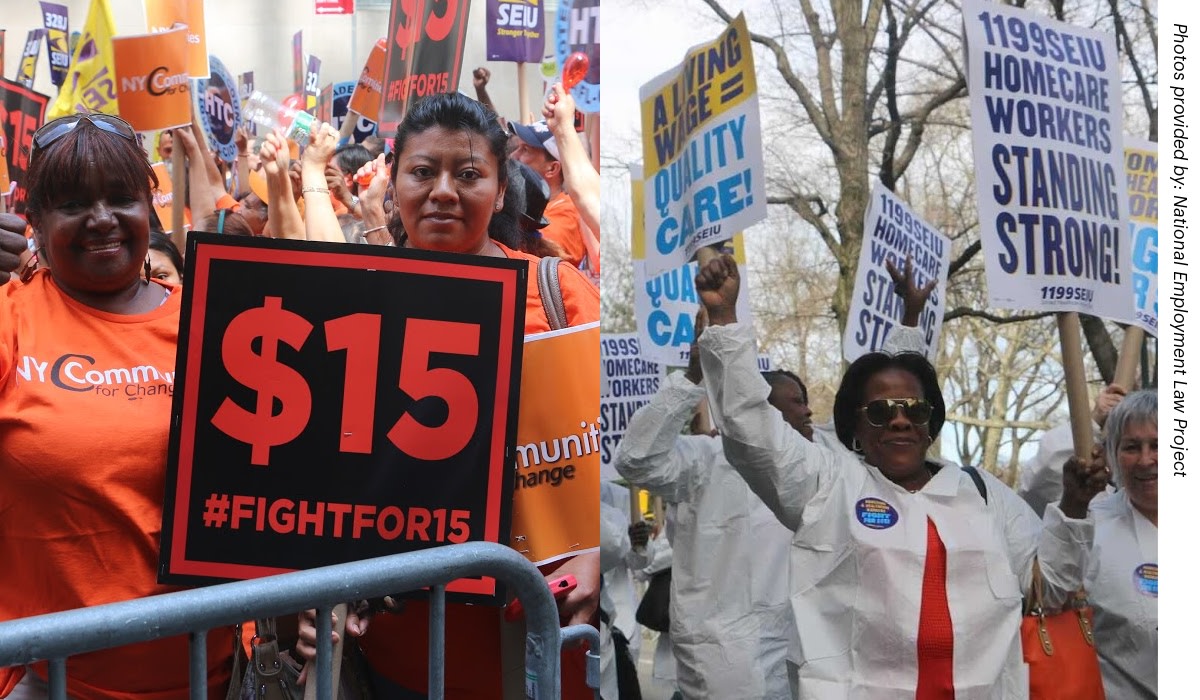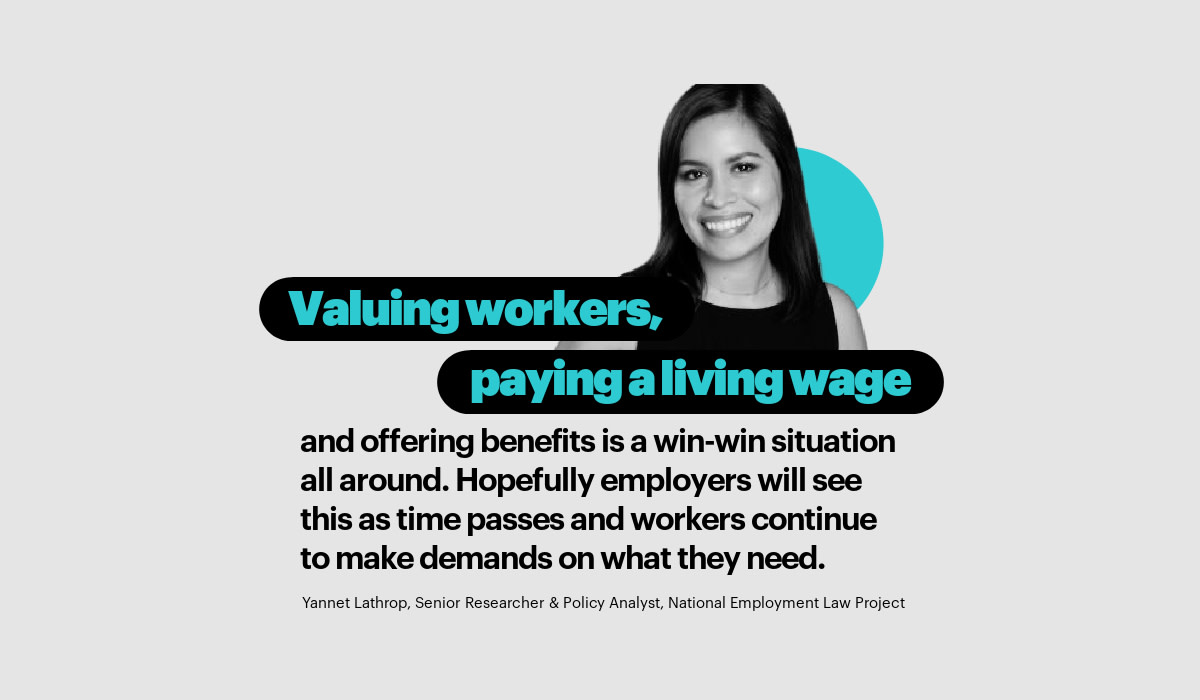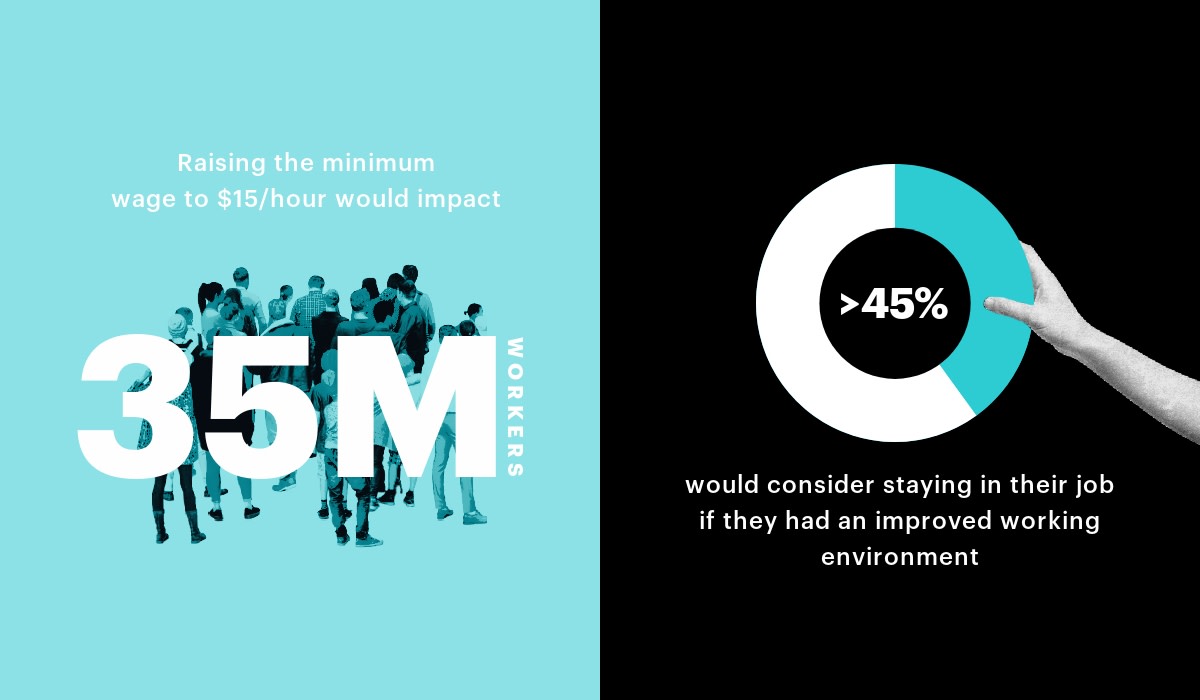Winning Back Unhappy Service Industry Workers Takes Pay & Appreciation
Returned service industry workers are now voluntarily leaving again, citing low pay and a lack of appreciation. Here's how employers can win them back.

Service industry workers were laid off en masse in 2020, but many who have come back are now voluntarily walking out the door again citing low pay and a lack of appreciation shown by employers. Could COVID be the catalyst needed to get companies to change the way they value hourly workers?
The profound cultural reckonings of late—#MeToo and the Black Lives Matter movements—have created a groundswell of collective discontent that forced the country to confront toxic and unchecked misogyny and racism head on. These movements sprung out of decades of injustice and mistreatment, leading to frustration and anger, finally reaching a critical breaking point where change wasn’t merely sought—it was demanded.
Now, with millions of low-wage workers abandoning their jobs in record numbers, it appears that the hospitality and service industries, along with the minimum-wage model they have been built upon, are facing a similar reckoning. In April this year, the Bureau of Labor Statistics reported that four million people quit their jobs—the highest number since 2020. And the reasons? In simple terms: they are fed up.
When the money isn’t worth the risk
For over a year now, grocery store workers, restaurant servers, cooks, and retail staff have risked their lives during the COVID pandemic, facing hostile customers and hazardous conditions, while making low wages that many are deeming not worth their time, nor the risk.
A telling study published by One Fair Wage in May showed that 53% of all workers surveyed were considering leaving their restaurant jobs—with 78% citing low wages and tips as the key reason.
For the last 12 years, the federal minimum wage has stayed at just $7.25/hour, which translates to only $15,080 for a full-time, year-round worker. Working full-time at minimum-wage makes any chance of upward mobility and economic security impossible but, according to labor rights organizations, raising the minimum wage to $15/hour would have an impact on over 35 million low-wage workers.
Yannet Lathrop, Senior Researcher at the National Employment Law Project, says between 1978 and 2018 CEO compensation grew by 940% while pay for the typical worker grew by only 12%. Her organisation provides critical research and support for those fighting to raise the minimum wage to $15/hour through a national campaign ‘Fight for $15.’
“For years, CEO compensation has been allowed to grow exponentially while workers’ pay has flat-lined. The more we allow the minimum-wage to linger at a poverty rate the more we will see these disparities between rich and poor, CEOs and average workers, the haves and have-nots. Paying a living wage helps narrow this income and wealth gap.”

NY Communities for Change activists demonstrate in support of the Fight for Fifteen in 2017
With 42% of the US workforce making less than $15/hour, the lack of service industry workers filling vacant positions may indicate it’s time for companies to rethink their wages in order to recapture those feeling let down and left behind.
“COVID-19 has highlighted the importance of workers’ demands and the value in the frontline work they do. Like all workers, service industry workers deserve a living wage and deserve good working conditions. So the combination of the pandemic and the fight for $15 has emboldened workers to help them see they are worth a lot more than just a poverty wage and poor conditions.”
Lathrop says workers are beginning to realize their power now that the industry is having a hard time finding employees.
“Workers now see that they have more choice — they are not going back to the ‘old normal’ where they were earning poverty wages and being exposed to infectious diseases, unpredictable schedules and having no benefits or paid time off. With the worker shortage it’s becoming clear to all of us that they are the ones who keep the economy working and provide the most essential services out there. Workers are starting to understand they have been essential all along and are now realizing their power and the importance of their job in this economy,” Lathrop says.
She also thinks paying a living wage is beneficial to all.
“Valuing workers, paying a living wage and offering benefits is a win-win situation all around and hopefully employers will see it as time passes and workers continue to make demands on what they need.”
Companies up their offers
With workers refusing to come back on old terms some companies are taking the opportunity to embrace change.
McDonald’s recently announced their franchises have raised hourly pay, offer paid time off and are even providing tuition coverage in a move to attract employees. Child and elderly care benefits for employees are also on offer.
Since the start of the pandemic, companies like Best Buy and Target announced they would raise their starting wage to $15/hour. Wayfair has done the same. Costco recently decided to go even further raising their base pay from $15 to $16/hour.
One company who has long embraced paying their employees a living wage is Ben & Jerry’s.
“Paying our full-time employees a livable wage is a concept we’re thoroughly committed to,” said Matthew McCarthy, Ben & Jerry’s CEO in a statement emailed to Visier. “It’s antithetical to be an aspiring social justice company without focusing on doing the right thing with your own employees first.”
In 1988 the company incorporated its Mission Statement which committed them to the notion of ‘linked prosperity’ which means that as Ben & Jerry’s prospers, the community and the employees should also prosper. Their economic mission says the company should operate “on a sustainable financial basis of profitable growth, increasing value of our stakeholders and expanding opportunities for development and career growth for our employees.”
The current wage for full time workers with the company is $18.13/hour, nearly $7 more than Vermont’s minimum wage which is at $11.75/hour.

But increasing pay is only part of the solution to attract and retain hourly workers. Some companies are offering other enticing incentives to show employees they are valued.
Last year, Chobani not only announced they would increase their starting pay to at least $15/hour, in the midst of COVID, the company also implemented health and safety measures to protect their employees and gain their confidence. They offer meals and PPE to workers and offer daily childcare subsidies to support employees without childcare due to school and childcare center closures.
Happiness is key to retention
Workers say raising pay will only partly fix the problem, but creating a workforce that feels valued and appreciated is an even greater challenge.
Tia Graham, business strategist and author of Be a Happy Leader, calls herself the Chief Happiness Officer of her business, Arrive at Happy. She says the key to rebuilding the service industry has as much to do with increasing morale as it does increasing pay.
“Increasing morale, increasing people’s motivation isn’t necessarily about the money. It’s about having people feel valued, having employees feel they are appreciated.”
Graham says COVID has caused workers across all industries and at all levels to reassess what is important in life, what they want from their workplace, and how they see their future. She thinks it’s a great opportunity for companies to reset and rebuild with a focus on employee experience around value, purpose, and respect.

“If you want more customer loyalty, more retention, more customer satisfaction, it’s very difficult to do that if employees are not happy,” she explains. “It’s extremely important for every single business owner to be focused on employee happiness, especially when there’s been a reassessment of what matters in life.”
And the data supports the happiness claim. Over 45% of workers surveyed in the One Fair Wage study said they would consider staying in their job if they had an improved working environment with less hostility from customers, co-workers, and management.
The thought of resetting the culture of a company, big or small, can be daunting. But in hospitality, you’re only as good as the staff you keep. And when your company relies on service, it’s your workers you’ll rely on to get back on your feet.
5 tips to rebuild a stronger (and happier) workforce
So with employees demanding new terms, better terms, respectable terms, what can companies do to attract good workers reluctant to come back and retain the great ones they already have?
1. Offer better pay. Commit to paying a living wage that your employees can start on and offer them pathways to climb higher within the business as their experience grows.
2. Invest in your workers and they will feel valued. You expect your employees to work their tails off for your business—to deliver the best service, the best products, and the best experiences. But it’s a two-way street. What can you offer them aside from a respectable wage? What incentives can you offer? What training and investments will you provide to make them feel valued?
3. Lay a groundwork of respect. Morale is tied to respect, happiness, and ultimately a sense of worth. If you have a workplace that is built upon respect, appreciation, and value, you will have happy employees. When you have happy employees, you have loyal employees. And, generally, when you have happy employees, you also have happy customers. So start with respect.
4. Offer flexibility and empathy. Life happens; many hourly workers require flexibility. Many low-wage workers are also parents, caregivers, and students. They have other things in their lives that may, at times, take priority over work. If you respect that, the happier they will be and the more reliable they will be.
5. Use people analytics data to understand the big picture. It’s difficult to make changes, big or small, without clear insights into where your organization is currently, and where you want to go in the future. Having current, clean data on tap will make implementing adjustments to your workforce simple, and allow you to try out different “what if” scenarios.
It’s clear that most service industry businesses struggled during COVID, and many are still on shaky ground. But so are their workers. With a workforce which bore the brunt of risk, sickness and hostility – compounded by low wages – there’s an opportunity now for companies to re-value the workers they so desperately need. Paying a living wage and creating a valuable workplace will give companies every chance they need to rebuild their businesses while also helping workers rebuild their lives.
Get Outsmart content straight to your inbox
Subscribe to the People Insights Monthly newsletter for actionable insights and stories.
Subscribe now